DAWSON CITY
There are more chum salmon in the Yukon River, but fishers haven’t seen a corresponding increase in their allowable catch, say locals.
Last October, commercial fisher Cor Guimond threw a net in the Sixty Mile River hoping to catch enough chum to feed his hungry dogs. Guimond, who is also a trapper, relies on his 16 dogs to navigate the bush in the winter.
Guimond tossed his net in the water on October 3, a few days before Canada opened up its fishing season.
He knew it was illegal, but reasoned that with the high numbers of fish passing through Eagle, Alaska, the salmon stock should have been healthy enough to fish.
Last Tuesday, he appeared at the territorial court in Dawson where he was issued a $1,000 fine for fishing out of season. He also had his fishing rights removed for two weeks and two of his nets permanently confiscated.
The government should be monitoring and working to conserve salmon stocks, he said. However, catchments must accurately reflect the number of fish in the water.
“When the fish aren’t there, I can understand why (the department doesn’t open fishing). But when they’re there, there’s no excuses.”
Last year, Fisheries and Oceans opened the chum salmon run on October 8.
“For the department (of Fisheries and Oceans) to open in late October is absolutely ludicrous,” said Guimond in court. “By then it’s cold and all the fish have gone by.”
The run should have been opened earlier, said Tim Gerberding, president of the Yukon River Commercial Fishing Association. But he doesn’t condone fishers flouting the law.
By the last week of September it was clear the chum run was going to be much stronger than expected. Reports from Alaska fisheries and the sonar counting station near Eagle, Alaska, indicated escapement targets for chum would be met, said Gerberding.
Meanwhile commercial fishers lobbied the department to open the fishery, but they “dithered,” he said.
Fisheries and Oceans opens the fishery once a certain number of salmon have passed the Eagle sonar station and have returned to spawn. Last year that target was set at 83,000 chum.
Ideally, Canadian fishermen should be taking in 29 to 35 per cent of the total allowable catch of chum salmon. The remainder of the catch is taken by American fishermen before the fish reach the Canadian border, according to an agreement drawn up between Canada and the US in 2002.
Once escapement goals have been met, a certain amount of fish are reserved for First Nation people before commercial fishers can harvest the salmon.
The season was open later last year because it “wasn’t a great run,” said fisheries management chief Sandy Johnston.
“It was just at the cusp for meeting First Nation and escapement requirements.”
Gerberding disputes that, citing the disproportionate amount of fish the Americans are allowed to take.
In 2009, Yukon fishers took in 1,113 Canadian-origin chum salmon while Americans took an estimated 26,000. That works out to Canadian fishers getting about four per cent of the total allowed chum salmon catch. The 26,000 the Americans caught also doesn’t include any American origin salmon of which US fishers took an additional 62,000 fish.
The amount of salmon Canadians are taking is much lower than the targets set out in the trans-boundary salmon agreement, said Gerberding, who helped negotiate the agreement.
The village of Eagle alone, with a population of 500, has taken more salmon in each of the past three years than the entire Yukon fishing industry, he said.
Ottawa is bowing to American pressure and not confronting Alaskan fish managers in the face of excess catches, he added.
But Americans have been promised a larger share of the catch because there are many more subsistence fishers in Alaska than there are in the Yukon, said Johnston.
“Alaskan communities are remote and are dependent on salmon. They’ve created a dependency on salmon over several generations,” he said.
“To allow all the Canadian fish go by without harvesting on their side means they would forgo all the US production - it’s a difficult situation.”
However, that argument doesn’t fly well with fishers in the Yukon.
“There’s only a handful of people that are allowed to fish in the Yukon,” said Guimond’s wife Lucie.
“We’re just trying to survive and live out in the bush and feed our dogs.
The Yukon Queen, a tourist boat that travels the Yukon River, kills thousands more fish than fisherman in the Yukon, she said.
“It’s just so unfair,” said Lucie.
“The Yukon Queen gets rich and we get punished. These guys get so much money for destroying the fish.”
Contact Vivian Belik at
vivianb@yukon-news.com
